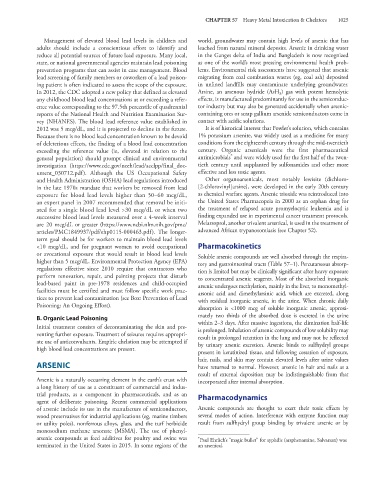Page 1039 - Basic _ Clinical Pharmacology ( PDFDrive )
P. 1039
CHAPTER 57 Heavy Metal Intoxication & Chelators 1025
Management of elevated blood lead levels in children and world, groundwater may contain high levels of arsenic that has
adults should include a conscientious effort to identify and leached from natural mineral deposits. Arsenic in drinking water
reduce all potential sources of future lead exposure. Many local, in the Ganges delta of India and Bangladesh is now recognized
state, or national governmental agencies maintain lead poisoning as one of the world’s most pressing environmental health prob-
prevention programs that can assist in case management. Blood lems. Environmental risk assessments have suggested that arsenic
lead screening of family members or coworkers of a lead poison- migrating from coal combustion wastes (eg, coal ash) deposited
ing patient is often indicated to assess the scope of the exposure. in unlined landfills may contaminate underlying groundwater.
In 2012, the CDC adopted a new policy that defined as elevated Arsine, an arsenous hydride (AsH ) gas with potent hemolytic
3
any childhood blood lead concentrations at or exceeding a refer- effects, is manufactured predominantly for use in the semiconduc-
ence value corresponding to the 97.5th percentile of quadrennial tor industry but may also be generated accidentally when arsenic-
reports of the National Health and Nutrition Examination Sur- containing ores or scrap gallium arsenide semiconductors come in
vey (NHANES). The blood lead reference value established in contact with acidic solutions.
2012 was 5 mcg/dL, and it is projected to decline in the future. It is of historical interest that Fowler’s solution, which contains
Because there is no blood lead concentration known to be devoid 1% potassium arsenite, was widely used as a medicine for many
of deleterious effects, the finding of a blood lead concentration conditions from the eighteenth century through the mid-twentieth
exceeding the reference value (ie, elevated in relation to the century. Organic arsenicals were the first pharmaceutical
*
general population) should prompt clinical and environmental antimicrobials and were widely used for the first half of the twen-
investigation (https://www.cdc.gov/nceh/lead/acclpp/final_doc- tieth century until supplanted by sulfonamides and other more
ument_030712.pdf). Although the US Occupational Safety effective and less toxic agents.
and Health Administration (OSHA) lead regulations introduced Other organoarsenicals, most notably lewisite (dichloro-
in the late 1970s mandate that workers be removed from lead [2-chlorovinyl]arsine), were developed in the early 20th century
exposure for blood lead levels higher than 50–60 mcg/dL, as chemical warfare agents. Arsenic trioxide was reintroduced into
an expert panel in 2007 recommended that removal be initi- the United States Pharmacopeia in 2000 as an orphan drug for
ated for a single blood lead level >30 mcg/dL or when two the treatment of relapsed acute promyelocytic leukemia and is
successive blood lead levels measured over a 4-week interval finding expanded use in experimental cancer treatment protocols.
are 20 mcg/dL or greater (https://www.ncbi.nlm.nih.gov/pmc/ Melarsoprol, another trivalent arsenical, is used in the treatment of
articles/PMC1849937/pdf/ehp0115-000463.pdf). The longer- advanced African trypanosomiasis (see Chapter 52).
term goal should be for workers to maintain blood lead levels
<10 mcg/dL, and for pregnant women to avoid occupational Pharmacokinetics
or avocational exposure that would result in blood lead levels Soluble arsenic compounds are well absorbed through the respira-
higher than 5 mcg/dL. Environmental Protection Agency (EPA) tory and gastrointestinal tracts (Table 57–1). Percutaneous absorp-
regulations effective since 2010 require that contractors who tion is limited but may be clinically significant after heavy exposure
perform renovation, repair, and painting projects that disturb to concentrated arsenic reagents. Most of the absorbed inorganic
lead-based paint in pre-1978 residences and child-occupied arsenic undergoes methylation, mainly in the liver, to monomethyl-
facilities must be certified and must follow specific work prac- arsonic acid and dimethylarsinic acid, which are excreted, along
tices to prevent lead contamination (see Box: Prevention of Lead with residual inorganic arsenic, in the urine. When chronic daily
Poisoning: An Ongoing Effort). absorption is <1000 mcg of soluble inorganic arsenic, approxi-
B. Organic Lead Poisoning mately two thirds of the absorbed dose is excreted in the urine
Initial treatment consists of decontaminating the skin and pre- within 2–3 days. After massive ingestions, the elimination half-life
is prolonged. Inhalation of arsenic compounds of low solubility may
venting further exposure. Treatment of seizures requires appropri- result in prolonged retention in the lung and may not be reflected
ate use of anticonvulsants. Empiric chelation may be attempted if by urinary arsenic excretion. Arsenic binds to sulfhydryl groups
high blood lead concentrations are present.
present in keratinized tissue, and following cessation of exposure,
hair, nails, and skin may contain elevated levels after urine values
ARSENIC have returned to normal. However, arsenic in hair and nails as a
result of external deposition may be indistinguishable from that
Arsenic is a naturally occurring element in the earth’s crust with incorporated after internal absorption.
a long history of use as a constituent of commercial and indus-
trial products, as a component in pharmaceuticals, and as an Pharmacodynamics
agent of deliberate poisoning. Recent commercial applications
of arsenic include its use in the manufacture of semiconductors, Arsenic compounds are thought to exert their toxic effects by
wood preservatives for industrial applications (eg, marine timbers several modes of action. Interference with enzyme function may
or utility poles), nonferrous alloys, glass, and the turf herbicide result from sulfhydryl group binding by trivalent arsenic or by
monosodium methane arsonate (MSMA). The use of phenyl-
arsenic compounds as feed additives for poultry and swine was * Paul Ehrlich’s “magic bullet” for syphilis (arsphenamine, Salvarsan) was
terminated in the United States in 2015. In some regions of the an arsenical.

